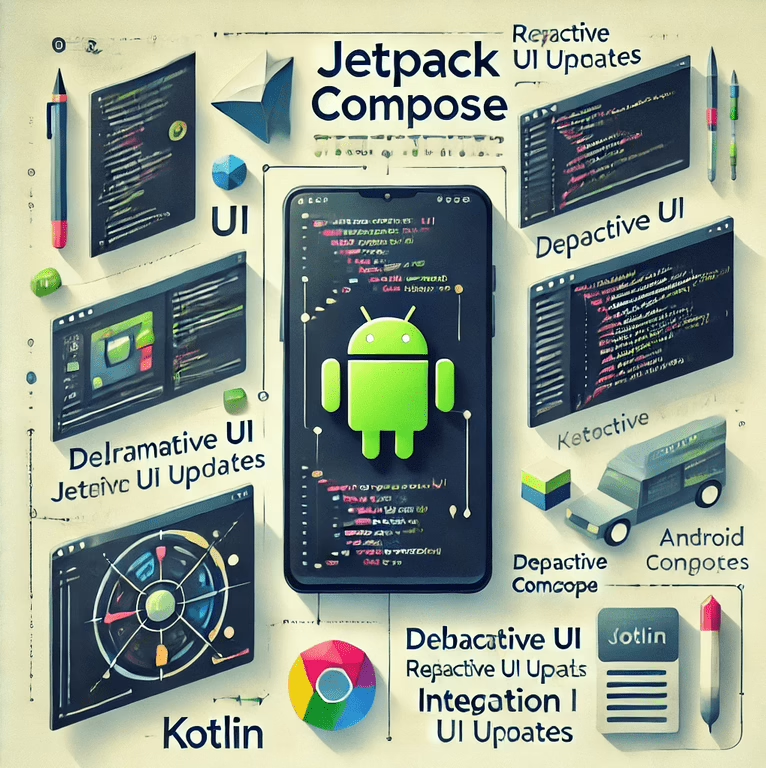In the dynamic landscape of Android app development, creating a seamless and intuitive user interface (UI) is paramount. Enter Jetpack Compose, a modern UI toolkit from Google that is revolutionizing how developers build native UIs for Android apps. Leveraging the Kotlin programming language and a declarative syntax, Jetpack Compose simplifies and accelerates UI development. This article delves into the core features and benefits of Jetpack Compose, explores its adoption within the Android development community, and highlights how Curate Consulting Services can help businesses find specialized talent to harness this powerful tool.
Understanding Jetpack Compose
Overview: Jetpack Compose is part of the Android Jetpack suite of libraries and tools designed to simplify and enhance Android app development. It provides a modern, fully Kotlin-based approach to building user interfaces, emphasizing a declarative and reactive programming model. By allowing developers to describe the UI in terms of its state and making it easier to maintain and update, Jetpack Compose addresses many of the challenges associated with traditional Android UI development.
Key Features of Jetpack Compose
Declarative UI: Jetpack Compose uses a declarative syntax, enabling developers to define UI components based on their current state. This approach simplifies the process of creating and managing UIs, as developers can focus on what the UI should look like rather than how to construct it step by step. By describing the UI in a concise and intuitive manner, Jetpack Compose reduces the complexity of UI code and enhances maintainability.
Fully Kotlin-Based: Written entirely in Kotlin, Jetpack Compose takes full advantage of the language’s modern features, including concise syntax, null safety, and extension functions. This not only makes the code more readable and expressive but also leverages Kotlin’s powerful capabilities to create robust and efficient UIs. Developers familiar with Kotlin will find Compose’s API natural and straightforward to use.
Reactive UI: In Jetpack Compose, UI components are reactive and automatically update when the underlying data changes. This reactive nature ensures that the UI consistently reflects the current state of the data, simplifying the process of managing UI updates and reducing the likelihood of bugs caused by inconsistent state.
Single Source of Truth: Jetpack Compose encourages the use of a single source of truth for UI data. This principle ensures that UI components always display the current state of the data, eliminating discrepancies between the UI and its underlying data model. This approach simplifies state management and enhances the reliability of the UI.
Compose UI Components: Jetpack Compose provides a rich set of predefined UI components such as Text, Button, and TextField. These components are highly customizable and can be combined to create complex and sophisticated UI layouts. The flexibility of Compose components allows developers to build unique and engaging user experiences.
Integration with Jetpack Libraries: Jetpack Compose is designed to work seamlessly with existing Jetpack libraries like ViewModel, LiveData, and Navigation. This integration allows developers to leverage other Jetpack components while using Compose for the UI layer, facilitating a cohesive and efficient development process.
Tooling Support: Android Studio offers robust support for Jetpack Compose, providing tools for visualizing and debugging UI layouts. Features like code completion, interactive previews, and an inspector for viewing the UI hierarchy make it easier for developers to build and refine their UIs.
Interoperability: Jetpack Compose can be used alongside existing UI frameworks, enabling a gradual adoption approach. Developers can integrate Compose components into existing apps or use Compose exclusively for new projects, offering flexibility in how they transition to this new paradigm.
Testing Support: Compose supports testing with tools like JUnit and UI testing frameworks, ensuring that developers can write tests to verify the behavior of their UI components. This support for testing promotes the development of reliable and high-quality applications.
Getting Started with Jetpack Compose
Setup: To use Jetpack Compose, developers need to include the necessary dependencies in their Android project. This typically involves adding the Compose libraries to the build.gradle file and configuring the project to use Kotlin.
Compose Functions: UI components in Jetpack Compose are created using composable functions, which are annotated with @Composable. These functions describe how UI elements should be displayed based on the current state, making it easy to build dynamic and responsive interfaces.
State Management: Jetpack Compose provides state management mechanisms, such as remember and mutableStateOf, to handle changes in UI state and trigger UI updates. These tools help maintain a clear and consistent state throughout the UI, simplifying the development process.
Preview and Testing: Android Studio’s preview functionality allows developers to visualize and interact with Compose UI components during development. This feature, combined with robust testing support, ensures that developers can efficiently build and validate their UIs.
Community and Adoption
Jetpack Compose has rapidly gained traction within the Android development community due to its modern approach to UI development. Google actively encourages developers to provide feedback and contribute to its evolution, ensuring that Compose continues to meet the needs of the community. As more developers adopt Jetpack Compose, its ecosystem of tools, libraries, and best practices continues to grow, making it an increasingly powerful and versatile tool for Android development.
The Role of Curate Consulting Services
As the demand for modern Android app development continues to rise, finding specialized talent proficient in Jetpack Compose is essential. Curate Consulting Services excels in helping businesses meet their staffing needs by connecting them with highly skilled professionals experienced in using Jetpack Compose and other advanced tools.
Our Expertise:
Talent Acquisition: Curate Consulting Services specializes in identifying and recruiting top-tier talent in Android development. Our extensive network and industry knowledge enable us to find candidates with the precise skills and experience needed for your projects.
Customized Solutions: We understand that every business has unique requirements. Our team works closely with clients to develop customized staffing solutions that align with their specific needs, whether it’s for short-term projects or long-term engagements.
Industry Knowledge: Our deep understanding of the Android development landscape allows us to provide valuable insights and guidance to our clients. We stay abreast of the latest trends and advancements, ensuring that we can deliver the most relevant and up-to-date talent solutions.
Conclusion
Jetpack Compose represents a significant shift in Android UI development, offering a more concise, expressive, and efficient way to build native user interfaces. Its declarative syntax, Kotlin-based approach, and reactive nature make it a powerful tool for creating modern Android apps. As the Android development community continues to embrace Jetpack Compose, its ecosystem will only grow stronger, providing developers with even more tools and resources to build exceptional UIs.
Curate Consulting Services is dedicated to helping businesses find the specialized talent needed to leverage Jetpack Compose effectively. Whether you’re developing a new Android app or enhancing an existing one, having the right expertise is crucial to your success.
If you’re looking to harness the power of Jetpack Compose for your next project or need expert assistance in finding the right talent, contact Curate Consulting Services today. Together, we can achieve remarkable results and push the boundaries of what’s possible in Android app development.



